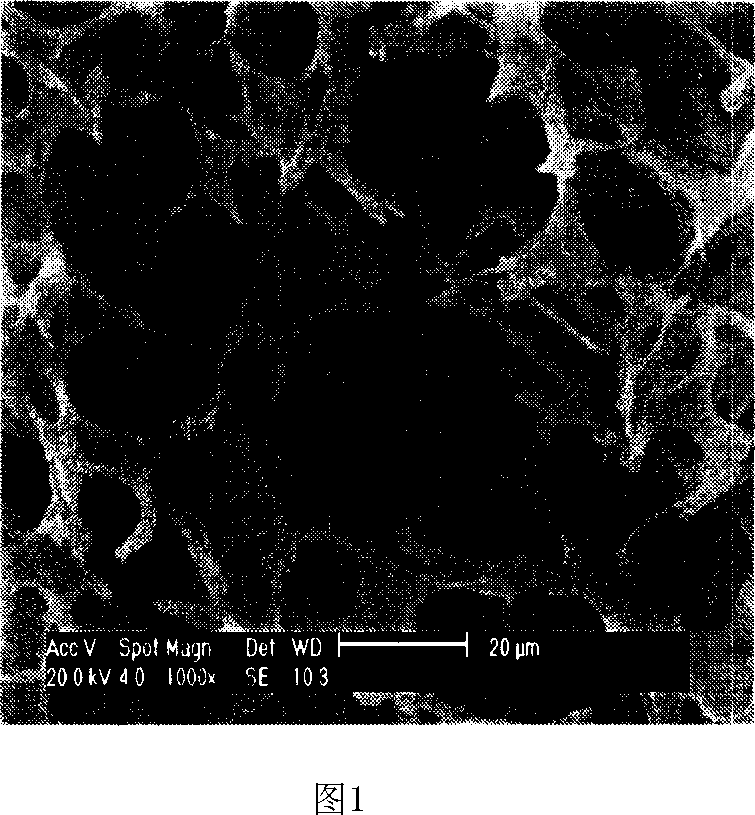Method for preparing 3D porous bracket of chitosan - copolymer of poly lactic acid
A polylactic acid copolymer, three-dimensional porous technology, applied in medical science, prosthesis, etc., to achieve the effect of strong connectivity, wide range of sources, and improved processing performance
- Summary
- Abstract
- Description
- Claims
- Application Information
AI Technical Summary
Problems solved by technology
Method used
Image
Examples
Embodiment 1
[0023] Weigh 1.5g of chitosan, dissolve it in 2.25g of DL-lactic acid, and stir for 0.5 hours until it dissolves completely. Weigh 2.5g of sodium chloride and add to this solution, stir mechanically for 3 hours, wait for uniform mixing, and heat at 50°C for 10 minutes. Pour the solution into a plastic mold, let it stand at room temperature for 24 hours, and then put it into an oven at 40° C. and dry it under normal pressure for 96 hours. In three steps, the dried and formed solids are heated and copolymerized under vacuum conditions:
[0024] ①40-50℃, 0.06MPa, heating for 1.5 hours
[0025] ②75-80℃, 0.08MPa, heating for 2-3 hours
[0026] ③85-95℃, 0.1MPa, heating for 2-3 hours
[0027] The solid matter taken out was continuously extracted with 500mL methanol for 24 hours, then placed in a vacuum drying oven, and further dried at room temperature and 0.1MPa for 48 hours to remove residual methanol. Then soak the solid matter in deionized water, change the water once every 2...
Embodiment 2
[0029] Weigh 1.5g of chitosan, dissolve it in 6g of L-lactic acid, and stir for 0.5 hours until it dissolves completely. Weigh 2.5g of sodium chloride and add to this solution, stir mechanically for 1 hour, wait for uniform mixing, and heat at 50°C for 5 minutes. Pour the solution into a plastic mold, let it stand at room temperature for 24 hours, and then put it into an oven at 30° C. and dry it under normal pressure for 96 hours. The vacuum copolymerization process is the same as above. The removed stent was continuously extracted with 500 mL of methanol for 40 hours, then placed in a vacuum drying oven, and further dried at room temperature and 0.1 MPa for 48 hours to remove residual methanol. Then soak the stent in deionized water, change the water every 24 hours, and wash it repeatedly 14 times, no sodium chloride can be detected in the deionized water after washing, and the wet stent is obtained. Wet scaffolds were freeze-dried at -50°C to prepare porous scaffolds. Th...
Embodiment 3
[0031] Weigh 1.5g of chitosan and dissolve it in 3g of lactic acid, stir for 1 hour until the dissolution is complete. Weigh 1.5g of potassium chloride and add to this solution, stir mechanically for 3 hours, wait for uniform mixing, and heat at 40°C for 10 minutes. Pour the solution into a plastic petri dish, let it stand at room temperature for 12 hours, and then put it into an oven to dry at 60°C under normal pressure for 36 hours. The vacuum copolymerization process is the same as above. The removed stent was continuously extracted with 500 mL of methanol for 40 hours, then placed in a vacuum drying oven, and further dried at room temperature and 0.08 MPa for 48 hours to remove residual methanol. Then soak the stent in deionized water, change the water once every 24 hours, and wash it repeatedly 14 times, no potassium chloride can be detected in the deionized water after washing, and a wet stent is obtained. Wet scaffolds were freeze-dried at -50°C to prepare porous scaf...
PUM
| Property | Measurement | Unit |
|---|---|---|
| Aperture | aaaaa | aaaaa |
| Aperture | aaaaa | aaaaa |
Abstract
Description
Claims
Application Information
 Login to View More
Login to View More - R&D
- Intellectual Property
- Life Sciences
- Materials
- Tech Scout
- Unparalleled Data Quality
- Higher Quality Content
- 60% Fewer Hallucinations
Browse by: Latest US Patents, China's latest patents, Technical Efficacy Thesaurus, Application Domain, Technology Topic, Popular Technical Reports.
© 2025 PatSnap. All rights reserved.Legal|Privacy policy|Modern Slavery Act Transparency Statement|Sitemap|About US| Contact US: help@patsnap.com

